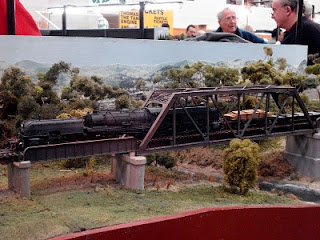Continuing on from the first instalment about last weekend's Rosehill Model Railway Exhibition, let me continue with some more layouts that grabbed my attention. I'll then finish up with some concluding comments.
A new layout (for me at least) was the HO scale Sydney suburban Carlingford branch terminus railway station. The layout depicts the terminus from the late 1980s to early 1990s. On the prototype, the Carlingford line was a relatively short suburban line (7km) forking off from Clyde on the Sydney Western line. The Carlingford line north of Parramatta Road was closed on 5 January 2020 to allow conversion works to light rail to take place. This also involved the closure of Rosehill station and rail access to Rosehill Racecourse where the exhibition was held. The layout showcased a range of suburban electric sets, including the brightly coloured "Zoo train".
Cockle Creek (N scale) was another NSW-themed layout featuring a range of locomotives and rollingstock from the 1960-1980s. The prototype is situated on the Short North between Sydney and Newcastle. The layout is from the NSW N scale group.
Dungog (HO scale) made another exhibition appearance and continues to display some of the best modelling of the NSW prototype. Dungog is on the Main North Coast Railway line to Brisbane. You can see a wide range of prototypes on the layout as it showcases action from the 1940s to 1970s. I always take time to look at the station and yard infrastructure on this layout as they are of excellent quality. And, of course, one cannot enjoy Dungog without taking note of the iconic layout lighting.
Wingello (HO scale) was another NSW-themed layout being based on the prototype station on the Main South line in the Southern Highlands of New South Wales, 132km from Sydney Central. The layout is from the Georges River Model Railway Club. The layout features a range of trains from the 1960s through to the 1990s. This was a nicely detailed layout with some excellent scratchbuilt structures.
Gunning (N scale) made another appearance, folowing on from Canberra last month. Gunning is a small town on the Main South line and is a popular spot for railway photographers. The layout incorporates the railway station and infrastructure of Gunning, as well as some additional railway structures to the north and south of Gunning itself.
Also on the Main South line, north of Gunning, is the major regional town of Goulburn. The Guildford Model Railway Club's exhibition layout of Goulburn (HO scale) is a great representation of the station and yard infrastructure. You can always be assured of plenty of railway action on this layout.
Another favourite on the exhibition circuit is Waterfall (HO scale) from the Illawarra Model Railway Association. The prototype location of Waterfall is 38km south of Sydney Central on the Illawarra line. The period showcased by this layout is the 1960s, well before electification in 1980. All of the buildings and structures are scratchbuilt. Track is Peco Code 83. Operation can be either DC or DCC.
Turning now to some overseas prototypes, we start off with the HO scale US-themed layout, Springfield Junction from the Hills Model Railway Club. This layout has many industries and plenty of railroad action. Operation is with digital command control (DCC).
Erbschaft (HO scale) was a wonderful layout from Ross James and son, particularly given that much of the buildings, locos and rolling stock came from Ross's father's collection from the 1960s and 1970s. The layout depicts a fictitious West German town in the 1960s. The layout uses the centre-stud Marklin track and locomotives. The buildings are early Faller and Kibri. None look the worse for wear! I spent quite some time enjoying this layout and all it had to offer. A very well composed layout indeed.
Another German layout was Luneberg from the Marklin Modellers Sydney club. The layout features the medieval town of Luneberg in northern Germany. This layout had some very nice buildings, as well as showcasing a variety of trains from Era III to the latest high-speed trains. The layout also uses the Faller car system and the town was well serviced by regular buses.
I'll finish up with another of my favourites from the exhibition: Uley Junction (O scale). The layout is based on a fictitious location but following Great Western Railway (GWR) practices. Being a branch line terminus, there are a number of short trains coming and going, as well as plenty of shunting. The layout showcases two periods of operation - late 1800s-early 1900s, and the 1930s. As such, there is a very interesting array of trains that you can see on this layout throughout the day. The layout uses a turntable fiddle yard (which is pretty big!), being able to hold and turn a train of 1200mm in length.
As well as a great and varied selection of layouts on show at the exhibition, there was also a wide range of commercial vendors as well. These included, ARHS bookshop, Alco World Trains, AndIan Models, Auscision, Bergs Hobbies, Burfitt Tools, Casula Hobbies, Eureka, Euro Hobby, Forest Miniatures, Hobbyland Hornsby, IDR, Ixion, Kerroby Models, Model Railroad Craftsman, Pallas Hobbies, SCMRS, SDS, and Wombat Models. Apologies if I left anybody out. And I cannot forget to mention the exhibition's second-hand stall which is synonomous with the event.
The Epping Model Railway Club is to be congratulated for a first rate exhibition with plenty of layouts and commercial stands to make the day (or weekend) a truly engaging experience. Thanks, fellas!





















































